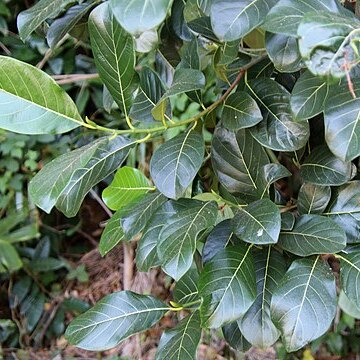Tree up to 40 m tall, sometimes with buttresses, evergreen. Leafy twigs 1.5-4 mm thick, (sparsely) whitish to brownish appressedly puberulous, smooth, drying pale to dark brown. Leaves distichous; lamina (sub)coriaceous, entire or pinnatifid to 3-5-lobate when juvenile, elliptic to (sub)ovate, (2-)10-20(-33) by (1-)4-12(-16) cm, apex acuminate, base cuneate to rounded (occasionally peltate with a narrow strip of laminar tissue connecting both sides), margin entire, ± revolute; upper surface (sub)-glabrous, smooth; lower surface densely minutely whitish puberulous to tomentose in the areoles or also on the reticulum, to sparsely whitish appressedly puberulous to subtomentose on the main veins, smooth, glaucous when fresh; lateral veins (6-)8-15 pairs, rarely forked away from the margin, tertiary venation scalariform, ± prominent; petiole (0.5-)1-2.5(-4.5) cm long, 1-2.5 mm thick, sparsely to densely whitish appressedly puberulous, the epidermis persistent; stipules lateral, 0.3-0.5 cm long, brownish appressedly puberulous, caducous. Staminate inflorescences axillary, solitary or in pairs; peduncle 1-3 mm long, minutely brownish puberulous; head cylindrical to clavate to ellipsoid, (5-)10-15(-25) mm long, 2-4 mm diam.; perianth 2-or 3-parted, c. 0.5 mm long; stamen c. 0.8 mm long, anther c. 0.2 mm long; interfloral bracts (sub)peltate, the apical part c. 0.4 mm diam., puberulous. Pistillate inflorescences axillary, solitary; peduncle 2-5 mm long, densely brown puberulous; head subglobose; stigma simple; interfloral bracts peltate, the apical part 0.2-0.3 mm diam., puberulous. Infructescences subglobose, up to 7 cm diam., densely whitish to brownish puberulous (to velutinous); fruits ellipsoid, c. 1 cm long.
More
Tree to 26 m high, with milky exudate; branchlets appressed-puberulous, glabrescent. Leaves: lamina ovate to elliptic, attenuate to acuminate at apex, cuneate to rounded at base, often slightly asymmetric, entire margin or occasionally lobed (juvenile plants with lobed leaves), 5–25 cm long, 3–8 cm wide, glabrous above (midvein with appressed to erect hairs, glabrescent), appressed-puberulous to glabrescent and often grey-glaucous below; lateral veins 6–14 pairs, arching, prominent below; petiole (0.6–) 1–2 cm long, puberulous; stipules to 1 cm long, pubescent. Inflorescence solitary or paired, pedunculate; interfloral bracts peltate. Male head clavate, 3–10 (–12) mm long, 3–6 mm diam. (2–3.5 mm diam., fide Dixon 2011: 2); bracts thinly stalked; peduncle 1–4 mm long. Male flowers c. 0.6 mm long; tepals 2 or 3; stamen c. 0.8 mm long, filament cylindrical. Female head globose. Syncarp subglobose, often lobed, to 2 (–3) cm diam., maturing orange-red; peduncle 2.6–4.4 mm long.
A tree. It grows 40 m tall. The trunk is 80 cm across. The leaves are oval or oblong and taper to a short tip. The leaves are shiny and leathery. They are 25 cm long. There are small hairs underneath. The female flowers are orange. The fruit are 2-3 cm long.


